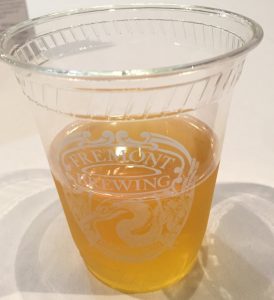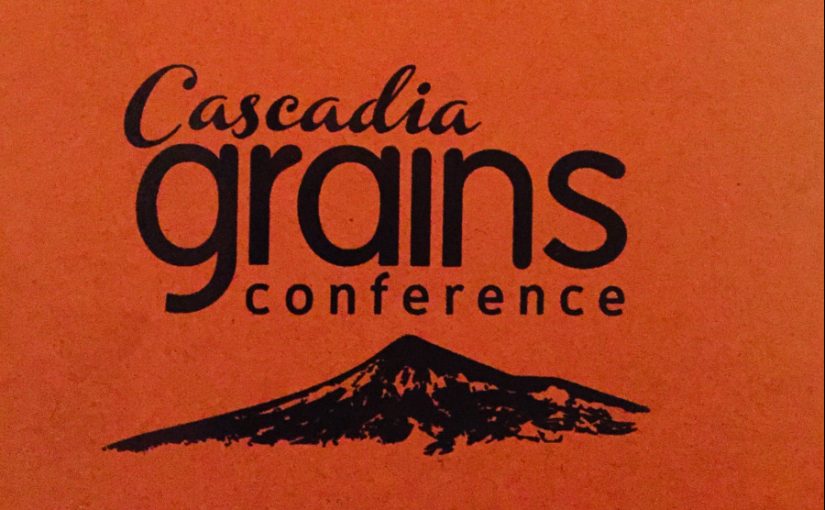Attending the Cascadia Grains Conference was an amazing experience. Prior to the conference I was not fully convinced that twelve hours of lectures and panels specifically on grain would be enjoyable; I was wrong. The content of these lectures left me yearning for more knowledge, and the connections made will be lifelong resources in my research.
Before attending any specific session I decided to make a round of the booths set up in the main hall. The first booth that I stopped at was one showing how different large-scale grain farms were implementing no-till systems. This was intriguing on a large scale; these farms were planting directly into previous years straw, similar to my learning on smaller farms. The most interesting booth was one run by the city of Tumwater to revitalize the old Olympia brewery, and turn it into an education and history center. John Doan, city administrator of Tumwater, and Ann Cook, communications manager were working this station. They offered information on the project and asked for support through an internship. (I might soon take them up on this offer) The project to redevelop this landmark will begin with reaching their 6 million dollar goal for funding. The Tumwater Craft Brewing and Distilling Center will offer an incubation space for new brewers and distillers to begin crafting an amazing product. In addition, there will be tasting rooms, a restaurant, museum, laboratory, teaching kitchen, entertainment area, farmers market and more! Through this project they intend to create 662 jobs and provide a community hub for PNW local commerce.
The first panel I attended was titled: Brewing With Specialty Grains. Sara Nelson, co-owner of Fremont Brewing in Seattle, facilitated this panel. On the panel were head brewers from four different breweries that frequently, or solely use specialty grains in their brewing process. First to speak was Patrick Jansen from Matchless brewing. (He definitely packed his 15 minutes full, almost to a point where it was difficult to take notes) Patrick began his short speech by bringing up the organoleptic differences that adding specialty grains can have on a beer. Most additives are to enhance flavor or mouth feel such as spelt or oats. The higher protein levels give more body to the beer; increase silkiness and overall sensory complexities. The other take away from this speaker was that if an organic brewery is the end goal, then you have to plan and start the brewery with that plan initially, because it is difficult to transition.
The next speaker was Benjamin Acord, he was the head brewer at a smaller brewery called Evasion Brewing. This speaker was much younger than the rest, and experimented with a variety of different malted grains. His main malts besides barley are millet, rice, and buckwheat. This is when I first began to contemplate the use of other malted grains as a base malt. Usually brewers will add some of these grains into their mash for flavor, color, and mouth feel, however this brewer was using some of these grains for entire mash bills. The one challenging part to using specialty grains as a base malt is the lack of small scale maltsters to convert the grain into a useable product. Developing a relationship with small-scale maltsters in integral to specialty grain brewing. The first speaker (From Matchless Brewing) had stated that specialty malts are sometimes challenging due to inconsistencies of the small maltsters. An interesting beer that Benjamin created for Evasion Brewing was simply just malted millet and wild yeast; people actually really enjoyed it!
Next, and by far the most interesting was Brewmaster Jason Yerger from Ghostfish Brewing. At 25 Jason was diagnosed with celiac disease; as a brewer he had to transition away from barley and into gluten free malts. His mission was to create a beer not for gluten free people, but rather to create a delicious beer that just so happens to be gluten free (I tried an extremely good IPA that he had brewed that was probably my second favorite from all of the tastings). The main malted grain used at Ghostfish is millet, they use between 75-80% for all malt. The main millet used is white millet, although some red millet is also used. Millet is spicy, light, and mildly astringent. It has hulls, not husks, so accidentally extracting unwanted tannins is not a problem, nor is the specific temperature of the mash when using millet. Mid-roast malted millet is the best, and is most similar to standard base malted barley. Crystal malts using millet are also similar to their barley equivalent. Buckwheat is another commonly used malted medium in Ghostfish’s lineup; it has an earthy, sweet taste, sometimes hints of cinnamon, and even strawberries. Buckwheat cannot be used on its own with out great difficulty. It makes for a very thick wort when mashed alone that filters poorly, however, when used with other malts, buckwheat can be a substitute for wheat or oats. Specifically Thai varieties of Red, black and purple rice add strong flavors similar to roasted barley, and their husks help eliminate mash compaction. These varieties of rice raise PH of mash. There is a current issue of malting equipment not being suitable for specialty grains; however, this will soon be fixed. Small-scale malting is gaining popularity and local facilities are becoming more common. For the Pacific North West, Skagit Valley Malting offers malting services of local grains in batches up to 10 tons. When the panel was then opened up the brewers all agreed that forward contracting is important for procuring malt and hops. Forward contracting will ensure that the breweries will get the freshest products, and that they will have enough to last them.
The next relevant panel was titled: Distilling Local-PNW Terroir. This was an incredible look into flavors that the different microclimates and soil of the Northwest have to offer distillers. The first to speak was John Bourdon, owner and distiller of Sandstone Distillery. He spoke of his trials with different varieties of grains sourced in the Northwest. Bourdon only releases one barrel at a time as needed of his different spirits. In addition to his regular spirits, which include whiskey, bacon whiskey, vodka, and gin, he is also currently running a 12-variety test of malts in whiskey. Different barley varieties are being used from different locations with different soils and climates. Bourdon says that the difference of

flavor and specific terroir is genuinely detectable only after distilling and more so aging. The next speaker was Jason Parker from Copperworks Distilling. Parker (the old brew master for Pike Brewing at its inception) began by informing the audience that malt notes, and terroir is much more distinguishable in whiskey than beer. He is also running a large test on the terroir of the Northwest; his test is a single variety of malted barley, all grown in different locations, brewed and distilled with the exact same process. The whiskey is currently aging and will probably be ready for tasting, testing, and comparison next year. Parker believes that malt is the new hops. Next on the panel was a scientist from WSU Named Thomas Collins. Collins works on quantifying data on finished spirits related to malt production location and practices for brewing and distilling. He calls the science booze-omics, which is the interaction of raw materials to produce the finished product. Two main forms of chemical profiling are used to measure subtleties. The first is called Gas chromatography–mass spectrometry (GCMS), which measures volatile compounds. The other is called Ultra-High Performance Liquid Chromatography (UHPLC), which measures non-volatiles. Collins can actually tell what type of whiskey is being compared by looking at results. He then went spoke about how terroir can mean quite a lot more than just where and how the inputs are grown. The time, barrel selection, and other choice inputs can directly be associated with overall terroir. For example, North-East IPA’s taste similarly to one another, but the inputs are not grown in the Northeast. A large part of terroir is reflective of a region’s values. Terroir is quickly becoming a much more broad term for taste and process of place. Importance is placed on the cooperation, and relationships of growers and processors. The issue with some of these small-batch distillers is that the flavor might be different batch to batch. The quality of flavor and process is of much more importance for these processors than uniformity of the final product. The way to market a more expensive and dissimilar products is to tell a good story; from the producer, to the maltster, to the processor. When consumers understand the care, time, and effort that go into a product, then they will pay a premium price.
The last panel I attended was titled: Malting-The new Flavor Frontier. First to speak was Adam Foy, Sales Manager Of Skagit Valley Malting. Skagit malting is a fantastic facility in Northern Washington that only malts local grains, and provides to local processors. As stated above each of their batches are around 10 tons per load, per machine; they currently have three machines this size. This size is considered small-scale despite the sound of it. The full malting process of converting the starches of grain into sugars takes 7 to 9 days. It is a controlled germination, and heat treatment, all in a self contained system. Skagit Malting works closely with brewers to cater specifically to their malting needs. They are even developing systems so that they can malt more obscure grains, and seeds to keep up with the growing popularity and demand. They consider malt like a grape is to wine; specific flavors related to region. Skagit Valley Malting also is a licensed micro-brewery that tests its malts by doing smash batches of beer; this means single malt, and single hop and uses the same recipe each time, to figure out specific nuances in the malt. Malted grains can also be made into sugary flours for baking and can replace some, or all white sugar in some recipes. Malted flour adds a delicious caramel flavor to baked goods.
Next on the panel to speak was Scott Fisk from OSU. Scott, students and other staff are working to do micro-scale new varietal malting to discover the best variety of barleys for different brewing and distilling applications. Their malting machine malts 100-300 pounds of grain at a time, which is then nano-brewed in facility to test flavor profiles. They log flavors and phenotypes using Quantitative trait locus (QTL) mapping. Their main contributors to overall flavor of grain is similar to above mentioned factors; these include malt house, location grown, process, and variety.
Joel Williamson from LINC Foods spoke next. Joel and his company are focused on rebuilding the malting system and help connect the three areas of the process: producers, maltsters, and processors. Their malting project includes a small malting facility, as well as acting as a middleman for these services.
Next was James Wahl of MJW Grains. Wahl mainly grows triticale, which is a cross of durum wheat and rye. He says it creates amazing beer, and whiskey, is simple to grow and does not need much water. Wahl lives on the Eastern side of Washington and has to grow varieties that require little water. This next year his main crop will be a specific red wheat that his father used to grow. He works closely with the processors who receive his grain, and makes sure it is what they want. He believes through his lasting relationships he will “recession-proof his farm”. Part of this plan means no longer exporting his grains, and no longer selling at commodity prices. He uses a no till system and plants directly into the previous straw.

The most important thing it would seem is for language to be developed to better describe malts, because then they would thrive. As Jason Parker said, malt is the new hops. Malt flavor has to be better understood before it can fully be appreciated. Another astonishing take away is that in a 15 barrel system there would only be a 1.7 cents difference per pint if Skagit’s Copeland malt was used over the leading premium two-row. This malt has better flavor, quality, and can make for a more efficient mash by ten percent.
